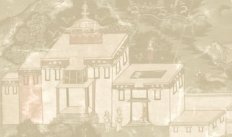
The Pakmodrupa dynasty, descended from the ancient Lang clan of Tibet’s imperial Yarlung period, ruled Tibet from the middle of the fourteenth to the fifteenth century, after the rule of the Sakya Khon family and before the Rinpungpas. The foundations for the Pakmodru polity were laid in the early twelfth century by Pakmodrupa Dorje Gyelpo who established the great Densatil Monastery and founded a new subsect of the Kagyu school. Pakmodrupa Jangchub Gyeltsen (1302-1364), the patriarch of the Pakmodru line, established the new Pakmodru government in central Tibet after fighting against the Sakya heirarchs and displacing them in 1350. In 1354 the Mongol Emperor accepted the coup and gave Jangchub Gyeltsen the title of Tai Situ, implying that he ruled as regent for the Mongol emperor but in reality Mongol power was waning. By the time the Yuan dynasty fell in 1368, the Pakmodrupa government, located at Nedong Castle in present day Tsetang, was consolidated enough to survive as a central government, at least until 1435 when the Rinpungpa came into power.